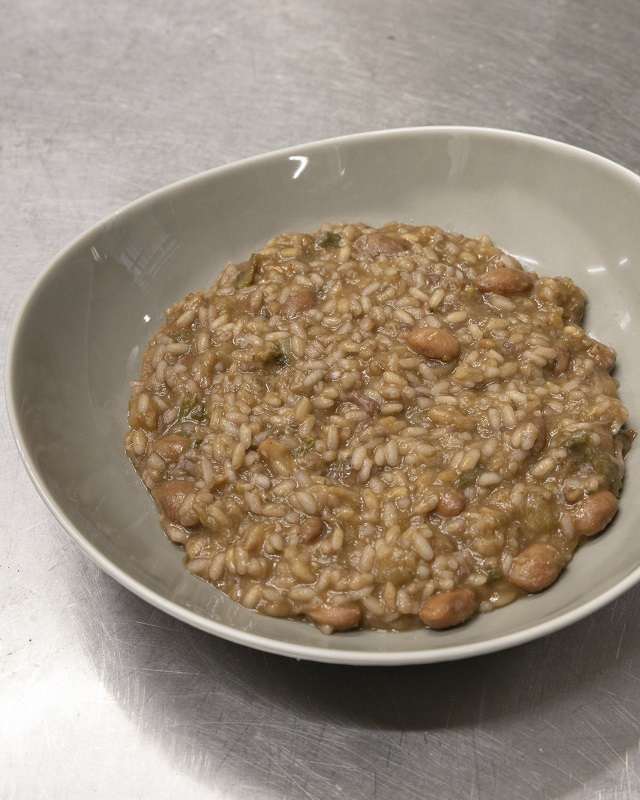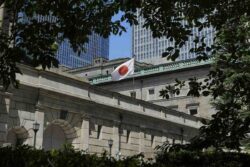
The rice fields of northern Italy should be inundated with water. Instead, many are dry and dying
11:53 JST, July 23, 2022
VESPOLATE, Italy – There’d been a single day of good rainfall all year, the afternoon temperature was again nearing 100 degrees, and Fabrizio Rizzotti walked into his fields – 220 acres of rice, a plant that grows by being submerged in water.
He didn’t need his boots.
The rice stems were desiccated and stunted. The field, rather than lush with shin-high water, crunched underfoot. Rizzotti, a seventh-generation rice farmer, said the paddy was already dead – “not a single grain of rice can come from this,” he said – and then he gestured to an adjacent field, slightly greener, and in dire need of more water.
“In a few days that field will be dead, too,” he said. “It’s stomach-churning.”
In Europe’s sweltering summer, few places have been hit more directly than northern Italy, where extreme drought has dried up a major river, triggered a state of emergency, and put the country’s famed agricultural flatlands in profound trouble. The drought is also causing Italians to fret about the things they’ve taken for granted: not just green rice fields typical of this region, but also the foods derived from them. Especially risotto.
“Less rice will mean costlier risotto,” Rizzotti said.
Italian rice is risotto rice – ideal for absorbing flavors while still staying intact – and Rizzotti is the kind of farmer who cares about food as much as his crops. He named his dog Risotto. And even his last name brings the dish to mind.
For most of his life, Rizzotti has eaten risotto several days per week: first in recipes prepared by his mother, and then his wife, and now – he said with melancholy – his mother again, who has been pitching in with the cooking since his wife died of leukemia in April.
Rizzotti said he had no choice but to carry on. Another year of seeding. Another period of 15-hour days powered by the local risotto of choice, heavy with pork and beans.
But as periods of extreme climate become more common, he is starting to consider rice as a precious commodity. Italy’s main agricultural group predicts that yields this year will be 30% lower than normal. All around Rizzotti’s farm, other rice farmers are left to guess whether future years might be similar. In the irrigation trenches that run along Rizzotti’s property, fed with the help of a local canal system created in the 1860s, the water is normally several feet high. Now there’s just a sediment-heavy trickle.
“Basically, there is no water left,” he said.
On a recent afternoon, with sweat on his brow, he got in his car and checked on other parts of his property. The health of a field can change from place to place, depending on the makeup of the soil, the distance from the main water channels and the decisions of the farmer. But even Rizzotti’s healthiest fields, with the steadiest supply of water, had dark green splotches that signaled the beginning of dehydration. Crickets hummed; a few dragonflies buzzed above the browned grass. The only other movement was a neighbor’s sprinkler on the horizon – fanning what little water was left across a field of corn.
“Everybody is facing tough choices,” Rizzotti said. “My neighbor is watering his corn to save his cows. But he’s letting his rice die.”
The rice can only grow when it is inundated; an inch or two of standing water will work when the plant is young, the farmers say, but it needs six or seven inches into the deep summer. Rizzotti’s rice is missing all of those benchmarks. Last year, his company, which includes his son and one other employee, produced 350 tons of white rice. This year, he said, they’ll be lucky to reach 150 tons.
“And that’s the best-case scenario,” he said of a situation in which his take-home pay would slide from $30,000 to $15,000. “The only hope for even that is if it starts raining. Raining exponentially.”
But the forecast showed 95-degree days and nonstop sun for at least the next week.
This part of Italy, a plain between the Alps and the Po River, is the predominant rice-growing area in a country that accounts for half of the European Union’s rice.

Paniscia, the typical risotto of the area, is made with beans, fatty salami and red wine.
Farmers here, like winemakers, speak in poetic terms about the qualities of the air, the snowmelt and the soil, all factors in their crop.
Rizzotti – who uses century-old machinery in some of the steps to process his rice – gets animated talking about seeing the purity of his rice under a microscope. (No micro-fissures, he says.) When he sells his rice to restaurants in the region, he asks them to credit his farm, called Riso Rizzotti, on their menus.
“For people here, rice is the first food, right after a mother’s milk,” said Marta Grassi, a one-star Michelin chef with a restaurant, Tantris, in the nearby city of Novara.
Arborio is the most famous of the Italian rice varieties, synonymous among Americans with risotto. But in northern Italy, among grandmothers and chefs alike, it is derided as second-rate – a rice that quickly turns mushy and doesn’t hold its form. The prized rice, instead, is carnaroli, which stays al dente much longer.
“You need a risotto with texture,” said Claudia Fonio, 40, a chef at a restaurant near Rizzotti’s farm. “You need to taste the grain.”
She said her brother has rice fields as well, and they, too, are in trouble.
“As far as I’m concerned, this is the beginning of a series of crises that will happen again and again,” she said.
Fonio uses Rizzotti’s rice in her kitchen, and Rizzotti occasionally comes to her restaurant after work – as happened one recent evening. As Rizzotti took a seat, a sous-chef began preparing his risotto over the flame, with only a black fan to keep him cool. Some 20 minutes later, out came one of the regional classics – the paniscia, with a fatty salami – and Rizzotti didn’t wait for it to cool, even though it was still 95 degrees out.
“This is the way it should be,” he said of the dish. No stickiness. Every grain with flavor.
He ate quickly and got ready to leave. Back home, he said, his mother was skipping dinner on account of the heat.
“Well,” he said, “she did have two ice creams.”
Rizzotti said the heat and drought are now defining his job, which this time of year pertains largely to water management: deciding which fields get how much water. At meetings of the consortium that manages water distribution among farmers and has instituted quotas, there have been fights and screaming matches.
“One field pitted against another,” Rizzotti said. “A war of the poor against the poor.”
He considers himself not just a farmer but an investor and a strategist. The most pertinent question now is whether the extreme drought is an anomaly. Some of the farmers he knows are betting on things returning to normal. But Rizzotti said farmers might not want to face up to the reality, because it’s too painful.
“Because it means destroying a sector that goes back centuries,” he said.
Rizzotti said he’s spent wisely over the years. He has no crazy loans. In good times, he built up some savings. He said he can manage one tough year. But not a string of tough years. Recently, he started planting a little bit of soy, which is less water-dependent than rice. He said that down the road, he can imagine shifting 50% of his land to soy and wheat.
It’s a way, he said, to “lower the risk.”
It would also mean less risotto originating from Riso Rizzotti.
"News Services" POPULAR ARTICLE
-

American Playwright Jeremy O. Harris Arrested in Japan on Alleged Drug Smuggling
-

Japan’s Nikkei Stock Average as JGB Yields, Yen Rise on Rate-Hike Bets
-

Japan’s Nikkei Stock Average Licks Wounds after Selloff Sparked by BOJ Hike Bets (UPDATE 1)
-

Japanese Bond Yields Zoom, Stocks Slide as Rate Hike Looms
-

Japan’s Nikkei Stock Average Buoyed by Stable Yen; SoftBank’s Slide Caps Gains (UPDATE 1)
JN ACCESS RANKING
-

Keidanren Chairman Yoshinobu Tsutsui Visits Kashiwazaki-Kariwa Nuclear Power Plant; Inspects New Emergency Safety System
-

Imports of Rare Earths from China Facing Delays, May Be Caused by Deterioration of Japan-China Relations
-

University of Tokyo Professor Discusses Japanese Economic Security in Interview Ahead of Forum
-

Japan Pulls out of Vietnam Nuclear Project, Complicating Hanoi’s Power Plans
-

Govt Aims to Expand NISA Program Lineup, Abolish Age Restriction

























